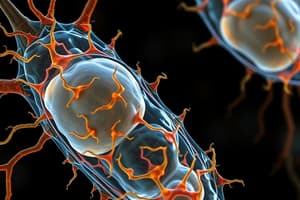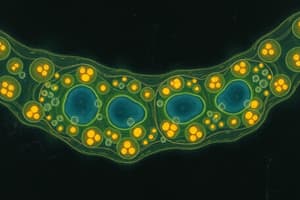Podcast
Questions and Answers
Which type of cells are connected by gap junctions to form syncytial tissues?
Which type of cells are connected by gap junctions to form syncytial tissues?
- Epithelial cells (correct)
- Skeletal muscle cells
- Cardiac muscle cells
- Neurons
Where are electrical synapses common?
Where are electrical synapses common?
- In vertebrates
- In invertebrates (correct)
- In neurons
- In skeletal muscle
What is the function of electrical synapses?
What is the function of electrical synapses?
- To alter the activity of postsynaptic neurons
- To cause muscle contraction
- To increase/decrease smooth muscle contraction (correct)
- To release hormones into the blood
What is the molecular-weight cutoff for gap junctions?
What is the molecular-weight cutoff for gap junctions?
What happens when cell Ca++ levels decrease?
What happens when cell Ca++ levels decrease?
Which type of cells release enzymes into the gut?
Which type of cells release enzymes into the gut?
What is the purpose of synapses?
What is the purpose of synapses?
Which type of synapse involves the opening of postsynaptic ion channels?
Which type of synapse involves the opening of postsynaptic ion channels?
Which of the following can result from transmitter binding to postsynaptic receptors?
Which of the following can result from transmitter binding to postsynaptic receptors?
Which neurotransmitter is inhibitory at the heart?
Which neurotransmitter is inhibitory at the heart?
Which neurotransmitter is derived from tyrosine and acts as a circulating hormone?
Which neurotransmitter is derived from tyrosine and acts as a circulating hormone?
Which neurotransmitter is the major inhibitory transmitter in the spinal cord?
Which neurotransmitter is the major inhibitory transmitter in the spinal cord?
Which mechanism decreases the concentration of transmitter-receptor complexes in the synaptic cleft?
Which mechanism decreases the concentration of transmitter-receptor complexes in the synaptic cleft?
Which toxin permanently poisons synapses by preventing vesicle release of acetylcholine from motor neurons?
Which toxin permanently poisons synapses by preventing vesicle release of acetylcholine from motor neurons?
Which type of synapse is the most common in the nervous system?
Which type of synapse is the most common in the nervous system?
What is the minimum amount of transmitter released in a vesicle?
What is the minimum amount of transmitter released in a vesicle?
What process is responsible for the uptake of molecules into a cell?
What process is responsible for the uptake of molecules into a cell?
What controls synaptic release at the presynaptic terminal?
What controls synaptic release at the presynaptic terminal?
What is the critical dependence for synaptic release?
What is the critical dependence for synaptic release?
What causes a decrease in synaptic release?
What causes a decrease in synaptic release?
What is the main factor contributing to the synaptic delay in chemical synapses?
What is the main factor contributing to the synaptic delay in chemical synapses?
Which toxin is almost as lethal as botulinum and permanently poisons GABA neurons by preventing vesicle release?
Which toxin is almost as lethal as botulinum and permanently poisons GABA neurons by preventing vesicle release?
Which spider venom causes uncontrolled dumping of synaptic vesicles and depletion of synaptic vesicles?
Which spider venom causes uncontrolled dumping of synaptic vesicles and depletion of synaptic vesicles?
Which substance blocks the uptake of choline into presynaptic nerve terminals of cholinergic neurons?
Which substance blocks the uptake of choline into presynaptic nerve terminals of cholinergic neurons?
Which type of paralytic poison paralyzes by binding to nicotinic ACh receptors, preventing EPP?
Which type of paralytic poison paralyzes by binding to nicotinic ACh receptors, preventing EPP?
Which substance blocks muscarinic-type ACh receptors, affecting the heart, glands, and iris of the eye?
Which substance blocks muscarinic-type ACh receptors, affecting the heart, glands, and iris of the eye?
Which depolarizing paralytic binds to nicotinic ACh receptors and produces sustained and large amplitude EPPs?
Which depolarizing paralytic binds to nicotinic ACh receptors and produces sustained and large amplitude EPPs?
Which class of drugs inhibits acetylcholinesterase at cholinergic synapses, preventing hydrolysis of ACh?
Which class of drugs inhibits acetylcholinesterase at cholinergic synapses, preventing hydrolysis of ACh?
Which drug is used clinically for the treatment of myasthenia gravis?
Which drug is used clinically for the treatment of myasthenia gravis?
Which substance is used as an antidote for poisoning by cholinesterase inhibitors?
Which substance is used as an antidote for poisoning by cholinesterase inhibitors?
Flashcards are hidden until you start studying
Study Notes
Cell Connections and Syncytial Tissues
- Muscle cells and nerve cells are connected by gap junctions to form syncytial tissues.
- Electrical synapses are common in neural networks, such as the cerebral cortex and the retina.
Function of Electrical Synapses
- The function of electrical synapses is to allow rapid transmission of electrical signals between cells.
Gap Junctions
- Gap junctions have a molecular-weight cutoff of approximately 1 kDa, allowing small molecules to pass through.
- When cell Ca++ levels decrease, gap junctions close, preventing the passage of molecules.
Cellular Functions
- Exocrine cells release enzymes into the gut to aid in digestion.
Synaptic Functions
- The purpose of synapses is to allow communication between cells through the transmission of signals.
- Ionotropic synapses involve the opening of postsynaptic ion channels, allowing ions to flow into the postsynaptic cell.
- Transmitter binding to postsynaptic receptors can result in depolarization, hyperpolarization, or modification of the postsynaptic cell.
Neurotransmitters
- Acetylcholine (ACh) is an inhibitory neurotransmitter at the heart.
- Epinephrine (adrenaline) is derived from tyrosine and acts as a circulating hormone.
- Glycine is the major inhibitory transmitter in the spinal cord.
Synaptic Transmission
- The process of synaptic transmission involves the release of neurotransmitters from the presynaptic terminal, binding to postsynaptic receptors, and the subsequent response of the postsynaptic cell.
- The mechanism of synaptic transmission is controlled by the concentration of transmitter-receptor complexes in the synaptic cleft, which can be decreased through the process of diffusional dissociation.
Toxins and Synapses
- α-Latrotoxin permanently poisons synapses by preventing vesicle release of acetylcholine from motor neurons.
- Botulinum toxin is a potent inhibitor of synaptic release, causing paralysis by blocking vesicle release.
- Tetrodotoxin (TTX) is a potent inhibitor of voltage-gated sodium channels, blocking action potential propagation.
- Black widow spider venom causes uncontrolled dumping of synaptic vesicles and depletion of synaptic vesicles.
- Hemicholinium-3 blocks the uptake of choline into presynaptic nerve terminals of cholinergic neurons, reducing ACh synthesis.
- α-Bungarotoxin paralyzes by binding to nicotinic ACh receptors, preventing end-plate potentials (EPPs).
- Atropine blocks muscarinic-type ACh receptors, affecting the heart, glands, and iris of the eye.
- Succinylcholine is a depolarizing paralytic that binds to nicotinic ACh receptors, producing sustained and large amplitude EPPs.
- Anticholinesterase drugs, such as neostigmine, inhibit acetylcholinesterase at cholinergic synapses, preventing hydrolysis of ACh.
- Pyridostigmine is used clinically for the treatment of myasthenia gravis.
- Pralidoxime is used as an antidote for poisoning by cholinesterase inhibitors.
Studying That Suits You
Use AI to generate personalized quizzes and flashcards to suit your learning preferences.


